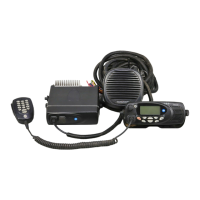70 Circuit Descriptions TM8100/TM8200 Service Manual
© Tait Electronics Limited November 2007
3.2 Receiver Circuitry
Introduction For a block diagram of the receiver circuitry, refer to Figure 3.3 (B1, H5,
H6 bands, 05 issue PCBs) and Figure 3.4 (other bands and later issue PCBs).
The receiver is of the triple-conversion superheterodyne type. The first two
IF stages are implemented in hardware; the third stage is implemented in the
FPGA (Field-Programmable Gate Array) of the digital board. The FPGA
also carries out the demodulation of the received signals.
Front-End Circuitry The front-end circuitry of all bands except K5 is a standard varicap-tuned
singlet (band-pass filter), followed by an LNA (low-noise amplifier), and
then a varicap-tuned doublet (image filter). The varicap tuning voltage
CDC
RX FE TUNE is provided by a DAC, with voltages calculated from a calibration
table stored in non-volatile memory. The two varicap-tuned filters need to
be calibrated to ensure that maximum sensitivity is achieved.
The K5 receiver has a dual 700MHz/800MHz front-end. This consists of a
switch followed by a SAW (surface acoustic wave) filter, then an LNA (low-
noise amplifier), and then a second SAW filter and a second switch. The
varicap tuning voltage
CDC FE TUNE is used to control the switches that select
which front-end is used.
First Mixer The first mixer of all bands except K5 is a standard diode-ring mixer with
SMD (surface-mount device) baluns and a quadruple SMD diode. For the
bands between 66 and 174MHz (A4 and B1), the receiver includes a circuit
for suppressing ignition noise. This circuit momentarily removes the LO
(local oscillator) signal from the mixer when an ignition noise pulse is
detected. The ignition-noise suppressor is selectable on a per-channel basis
when the radio is programmed. The noise blanker is generally not fitted to
trigger-base variants of the radio as it is not required in a fixed station
environment.
The first mixer of the K5 band is an integrated high performance mixer
(IC409). The first LO signal from the VCO is tapped from the collector
of Q504.
The first LO injection is low side for all bands except the 66 to 88MHz
A4 band. In the 762 to 870MHz K5 band radios, the first LO injection
is high side for the 762 to 776MHz sub-band and low side for the 850
to 870MHz sub-band.
First IF Stage and
Second Mixer
The first IF stage consists of a crystal channel filter (BPF1), followed by an
IF amplifier, and then another crystal filter (BPF2). The second mixer is an
IC quadrature mixer with an internal AGC amplifier. This IC has a divide-
by-two function on the LO input in order to provide the quadrature LO
frequencies required internally. The second LO frequency is synthesized by
an integer PLL (IC403), which uses the TCXO frequency
SYN RX OSC
(13.0000 MHz) as its reference.

